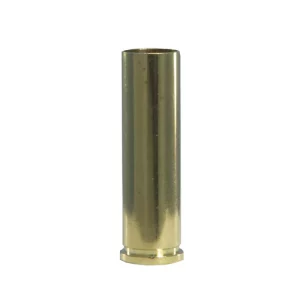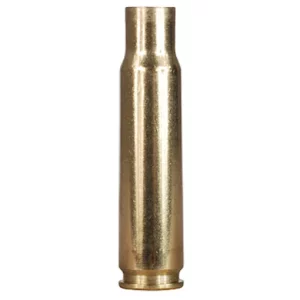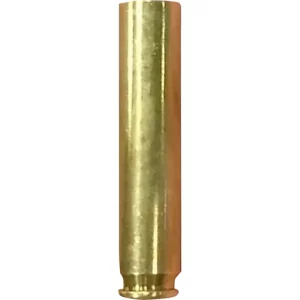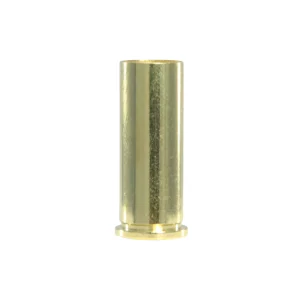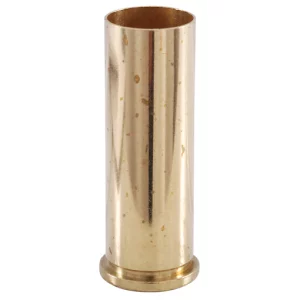Reloading Brass
-
Starline Brass 32-20 WCF
Designed for use in rifles and single action revolvers, this cartridge is making a strong comeback with the advent of cowboy action shooting. This cartridge can also be formed by experienced cartridge converters into .25-20 and .218 Bee. And with special forming dies available from RCBS and Lee, you can form a shortened version of the 7.62 Nagant cartridge. Overall length of this brass is 1.280-1.286″.
Note: The SAAMI spec for .25-20 & .218 Bee is smaller at the base than the .32-20 which can cause clearance issues on some rifles.
Starline Brass prides itself on producing the highest quality brass case available. Their brass is comprised of 70% copper and 30% zinc and is vertically drawn during the manufacturing process which results in more uniform wall thickness. Cases are annealed between each draw to ensure consistent metallurgy in all lots. Each brass case is hand inspected to guarantee the highest quality possible.
Starline Brass is located in Sedalia, MO and has been in business for over 30 years. Trust Starline for your next reloads, you won’t be disappointed. New, unprimed brass. This is not loaded ammunition. Bulk brass should be full-length sized, trimmed and chamfered before loading.
Brass Preparation: With bulk rifle brass you may sometimes notice a few case mouths are “out of round” or slightly dented below the shoulder. These imperfections occur in the final tumbling wash operation after the case mouth has been annealed. Brass manufacturers are aware of the case cosmetics and have worked to mitigate it, but due to equipment design, denting may still occur. Minor dents are normally removed in the first firing and will not affect case life or performance. On non-plated brass, you may also notice all the anneal stain might not be polished off, which may give the case neck a pinkish color. With some smaller caliber cases you may notice the case mouths to be slightly belled.
With all new rifle brass, you should first straighten out the case and case mouth, then chamfer and debur the case mouth inside and out. To straighten the case mouth, run the case part way into the sizer die and let the expander ball straighten the brass. To prevent the case neck from stretching, be sure to lubricate the case neck inside the case mouth.
If you are using Nickel plated brass, special care must be taken to lubricate the cases prior to sizing them. Nickel plating is harder than brass and the cases require more effort in sizing. In the event a case becomes stuck, purchase a stuck case remover; don’t use pliers, screwdrivers or other common household tools which could damage your sizing die.
CAD $55.76Starline Brass 32-20 WCF
CAD $55.76 -
Starline Brass 327 Federal Magnum
Starline Brass prides itself on producing the highest quality brass case available. Their brass is comprised of 70% copper and 30% zinc and is vertically drawn during the manufacturing process which results in more uniform wall thickness. Cases are annealed between each draw to ensure consistent metallurgy in all lots. Each brass case is hand inspected to guarantee the highest quality possible.
Starline Brass is located in Sedalia, MO and has been in business for over 30 years. Trust Starline for your next reloads, you won’t be disappointed. New, unprimed brass. This is not loaded ammunition. Bulk brass should be full-length sized, trimmed and chamfered before loading.
Brass Preparation: With bulk rifle brass you may sometimes notice a few case mouths are “out of round” or slightly dented below the shoulder. These imperfections occur in the final tumbling wash operation after the case mouth has been annealed. Brass manufacturers are aware of the case cosmetics and have worked to mitigate it, but due to equipment design, denting may still occur. Minor dents are normally removed in the first firing and will not affect case life or performance. On non-plated brass, you may also notice all the anneal stain might not be polished off, which may give the case neck a pinkish color. With some smaller caliber cases you may notice the case mouths to be slightly belled.
With all new rifle brass, you should first straighten out the case and case mouth, then chamfer and debur the case mouth inside and out. To straighten the case mouth, run the case part way into the sizer die and let the expander ball straighten the brass. To prevent the case neck from stretching, be sure to lubricate the case neck inside the case mouth.
If you are using Nickel plated brass, special care must be taken to lubricate the cases prior to sizing them. Nickel plating is harder than brass and the cases require more effort in sizing. In the event a case becomes stuck, purchase a stuck case remover; don’t use pliers, screwdrivers or other common household tools which could damage your sizing die.
CAD $44.00Starline Brass 327 Federal Magnum
CAD $44.00 -
Starline Brass 338 Federal
Starline Brass prides itself on producing the highest quality brass case available. Their brass is comprised of 70% copper and 30% zinc and is vertically drawn during the manufacturing process which results in more uniform wall thickness. Cases are annealed between each draw to ensure consistent metallurgy in all lots. Each brass case is hand inspected to guarantee the highest quality possible.
Starline Brass is located in Sedalia, MO and has been in business for over 30 years. Trust Starline for your next reloads, you won’t be disappointed. New, unprimed brass. This is not loaded ammunition. Bulk brass should be full-length sized, trimmed and chamfered before loading.
Brass Preparation: With bulk rifle brass you may sometimes notice a few case mouths are “out of round” or slightly dented below the shoulder. These imperfections occur in the final tumbling wash operation after the case mouth has been annealed. Brass manufacturers are aware of the case cosmetics and have worked to mitigate it, but due to equipment design, denting may still occur. Minor dents are normally removed in the first firing and will not affect case life or performance. On non-plated brass, you may also notice all the anneal stain might not be polished off, which may give the case neck a pinkish color. With some smaller caliber cases you may notice the case mouths to be slightly belled.
With all new rifle brass, you should first straighten out the case and case mouth, then chamfer and debur the case mouth inside and out. To straighten the case mouth, run the case part way into the sizer die and let the expander ball straighten the brass. To prevent the case neck from stretching, be sure to lubricate the case neck inside the case mouth.
If you are using Nickel plated brass, special care must be taken to lubricate the cases prior to sizing them. Nickel plating is harder than brass and the cases require more effort in sizing. In the event a case becomes stuck, purchase a stuck case remover; don’t use pliers, screwdrivers or other common household tools which could damage your sizing die.
CAD $59.84Starline Brass 338 Federal
CAD $59.84 -
Starline Brass 348 Winchester Box of 50 (Bulk Packaged)
Starline Brass prides itself on producing the highest quality brass case available. Their brass is comprised of 70% copper and 30% zinc and is vertically drawn during the manufacturing process which results in more uniform wall thickness. Cases are annealed between each draw to ensure consistent metallurgy in all lots. Each brass case is hand inspected to guarantee the highest quality possible.
Starline Brass is located in Sedalia, MO and has been in business for over 30 years. Trust Starline for your next reloads, you won’t be disappointed. New, unprimed brass. This is not loaded ammunition. Bulk brass should be full-length sized, trimmed and chamfered before loading.
Brass Preparation: With bulk rifle brass you may sometimes notice a few case mouths are “out of round” or slightly dented below the shoulder. These imperfections occur in the final tumbling wash operation after the case mouth has been annealed. Brass manufacturers are aware of the case cosmetics and have worked to mitigate it, but due to equipment design, denting may still occur. Minor dents are normally removed in the first firing and will not affect case life or performance. On non-plated brass, you may also notice all the anneal stain might not be polished off, which may give the case neck a pinkish color. With some smaller caliber cases you may notice the case mouths to be slightly belled.
With all new rifle brass, you should first straighten out the case and case mouth, then chamfer and debur the case mouth inside and out. To straighten the case mouth, run the case part way into the sizer die and let the expander ball straighten the brass. To prevent the case neck from stretching, be sure to lubricate the case neck inside the case mouth.
If you are using Nickel plated brass, special care must be taken to lubricate the cases prior to sizing them. Nickel plating is harder than brass and the cases require more effort in sizing. In the event a case becomes stuck, purchase a stuck case remover; don’t use pliers, screwdrivers or other common household tools which could damage your sizing die.
CAD $175.44 -
Starline Brass 350 Legend Box of 100 (Bulk Packaged)
Introduced by Winchester and approved by SAAMI in January of 2019, the .350 Legend is a brand new cartridge with no parent case. This tapered case has a rebated rim allowing it to utilize the standard .223 bolt face found on many common rifles including the AR-15. Like many other AR cartridges, the .350 Legend only requires changing the barrel and magazine. This cartridge’s allure is that it can be used for hunting in several states that allow straightwall cartridges only, but it doesn’t have near the recoil of other AR cartridges that fill this niche. Utilizing .355″ diameter bullets, the .350 Legend is capable of impressive ballistics, without a lot of recoil. Several bolt action and AR-type rifles are being produced in this caliber, with new models being added all the time.
Starline Brass prides itself on producing the highest quality brass case available. Their brass is comprised of 70% copper and 30% zinc and is vertically drawn during the manufacturing process which results in more uniform wall thickness. Cases are annealed between each draw to ensure consistent metallurgy in all lots. Each brass case is hand inspected to guarantee the highest quality possible.
Starline Brass is located in Sedalia, MO and has been in business for over 30 years. Trust Starline for your next reloads, you won’t be disappointed. New, unprimed brass. This is not loaded ammunition. Bulk brass should be full-length sized, trimmed and chamfered before loading.
Brass Preparation: With bulk rifle brass you may sometimes notice a few case mouths are “out of round” or slightly dented below the shoulder. These imperfections occur in the final tumbling wash operation after the case mouth has been annealed. Brass manufacturers are aware of the case cosmetics and have worked to mitigate it, but due to equipment design, denting may still occur. Minor dents are normally removed in the first firing and will not affect case life or performance. On non-plated brass, you may also notice all the anneal stain might not be polished off, which may give the case neck a pinkish color. With some smaller caliber cases you may notice the case mouths to be slightly belled.
With all new rifle brass, you should first straighten out the case and case mouth, then chamfer and debur the case mouth inside and out. To straighten the case mouth, run the case part way into the sizer die and let the expander ball straighten the brass. To prevent the case neck from stretching, be sure to lubricate the case neck inside the case mouth.
If you are using Nickel plated brass, special care must be taken to lubricate the cases prior to sizing them. Nickel plating is harder than brass and the cases require more effort in sizing. In the event a case becomes stuck, purchase a stuck case remover; don’t use pliers, screwdrivers or other common household tools which could damage your sizing die.
CAD $58.48 -
Starline Brass 357 Magnum
Starline Brass prides itself on producing the highest quality brass case available. Their brass is comprised of 70% copper and 30% zinc and is vertically drawn during the manufacturing process which results in more uniform wall thickness. Cases are annealed between each draw to ensure consistent metallurgy in all lots. Each brass case is hand inspected to guarantee the highest quality possible.
Starline Brass is located in Sedalia, MO and has been in business for over 30 years. Trust Starline for your next reloads, you won’t be disappointed. New, unprimed brass. This is not loaded ammunition. Bulk brass should be full-length sized, trimmed and chamfered before loading.
Brass Preparation: With bulk rifle brass you may sometimes notice a few case mouths are “out of round” or slightly dented below the shoulder. These imperfections occur in the final tumbling wash operation after the case mouth has been annealed. Brass manufacturers are aware of the case cosmetics and have worked to mitigate it, but due to equipment design, denting may still occur. Minor dents are normally removed in the first firing and will not affect case life or performance. On non-plated brass, you may also notice all the anneal stain might not be polished off, which may give the case neck a pinkish color. With some smaller caliber cases you may notice the case mouths to be slightly belled.
With all new rifle brass, you should first straighten out the case and case mouth, then chamfer and debur the case mouth inside and out. To straighten the case mouth, run the case part way into the sizer die and let the expander ball straighten the brass. To prevent the case neck from stretching, be sure to lubricate the case neck inside the case mouth.
If you are using Nickel plated brass, special care must be taken to lubricate the cases prior to sizing them. Nickel plating is harder than brass and the cases require more effort in sizing. In the event a case becomes stuck, purchase a stuck case remover; don’t use pliers, screwdrivers or other common household tools which could damage your sizing die.
CAD $35.36Starline Brass 357 Magnum
CAD $35.36 -
Starline Brass 357 Magnum
Starline Brass prides itself on producing the highest quality brass case available. Their brass is comprised of 70% copper and 30% zinc and is vertically drawn during the manufacturing process which results in more uniform wall thickness. Cases are annealed between each draw to ensure consistent metallurgy in all lots. Each brass case is hand inspected to guarantee the highest quality possible.
Starline Brass is located in Sedalia, MO and has been in business for over 30 years. Trust Starline for your next reloads, you won’t be disappointed. New, unprimed brass. This is not loaded ammunition. Bulk brass should be full-length sized, trimmed and chamfered before loading.
Brass Preparation: With bulk rifle brass you may sometimes notice a few case mouths are “out of round” or slightly dented below the shoulder. These imperfections occur in the final tumbling wash operation after the case mouth has been annealed. Brass manufacturers are aware of the case cosmetics and have worked to mitigate it, but due to equipment design, denting may still occur. Minor dents are normally removed in the first firing and will not affect case life or performance. On non-plated brass, you may also notice all the anneal stain might not be polished off, which may give the case neck a pinkish color. With some smaller caliber cases you may notice the case mouths to be slightly belled.
With all new rifle brass, you should first straighten out the case and case mouth, then chamfer and debur the case mouth inside and out. To straighten the case mouth, run the case part way into the sizer die and let the expander ball straighten the brass. To prevent the case neck from stretching, be sure to lubricate the case neck inside the case mouth.
If you are using Nickel plated brass, special care must be taken to lubricate the cases prior to sizing them. Nickel plating is harder than brass and the cases require more effort in sizing. In the event a case becomes stuck, purchase a stuck case remover; don’t use pliers, screwdrivers or other common household tools which could damage your sizing die.
CAD $35.36Starline Brass 357 Magnum
CAD $35.36 -
Starline Brass 357 Sig
Starline Brass prides itself on producing the highest quality brass case available. Their brass is comprised of 70% copper and 30% zinc and is vertically drawn during the manufacturing process which results in more uniform wall thickness. Cases are annealed between each draw to ensure consistent metallurgy in all lots. Each brass case is hand inspected to guarantee the highest quality possible.
Starline Brass is located in Sedalia, MO and has been in business for over 30 years. Trust Starline for your next reloads, you won’t be disappointed. New, unprimed brass. This is not loaded ammunition. Bulk brass should be full-length sized, trimmed and chamfered before loading.
Brass Preparation: With bulk rifle brass you may sometimes notice a few case mouths are “out of round” or slightly dented below the shoulder. These imperfections occur in the final tumbling wash operation after the case mouth has been annealed. Brass manufacturers are aware of the case cosmetics and have worked to mitigate it, but due to equipment design, denting may still occur. Minor dents are normally removed in the first firing and will not affect case life or performance. On non-plated brass, you may also notice all the anneal stain might not be polished off, which may give the case neck a pinkish color. With some smaller caliber cases you may notice the case mouths to be slightly belled.
With all new rifle brass, you should first straighten out the case and case mouth, then chamfer and debur the case mouth inside and out. To straighten the case mouth, run the case part way into the sizer die and let the expander ball straighten the brass. To prevent the case neck from stretching, be sure to lubricate the case neck inside the case mouth.
If you are using Nickel plated brass, special care must be taken to lubricate the cases prior to sizing them. Nickel plating is harder than brass and the cases require more effort in sizing. In the event a case becomes stuck, purchase a stuck case remover; don’t use pliers, screwdrivers or other common household tools which could damage your sizing die.
CAD $39.44Starline Brass 357 Sig
CAD $39.44 -
Starline Brass 357 Sig
Starline Brass prides itself on producing the highest quality brass case available. Their brass is comprised of 70% copper and 30% zinc and is vertically drawn during the manufacturing process which results in more uniform wall thickness. Cases are annealed between each draw to ensure consistent metallurgy in all lots. Each brass case is hand inspected to guarantee the highest quality possible.
Starline Brass is located in Sedalia, MO and has been in business for over 30 years. Trust Starline for your next reloads, you won’t be disappointed. New, unprimed brass. This is not loaded ammunition. Bulk brass should be full-length sized, trimmed and chamfered before loading.
Brass Preparation: With bulk rifle brass you may sometimes notice a few case mouths are “out of round” or slightly dented below the shoulder. These imperfections occur in the final tumbling wash operation after the case mouth has been annealed. Brass manufacturers are aware of the case cosmetics and have worked to mitigate it, but due to equipment design, denting may still occur. Minor dents are normally removed in the first firing and will not affect case life or performance. On non-plated brass, you may also notice all the anneal stain might not be polished off, which may give the case neck a pinkish color. With some smaller caliber cases you may notice the case mouths to be slightly belled.
With all new rifle brass, you should first straighten out the case and case mouth, then chamfer and debur the case mouth inside and out. To straighten the case mouth, run the case part way into the sizer die and let the expander ball straighten the brass. To prevent the case neck from stretching, be sure to lubricate the case neck inside the case mouth.
If you are using Nickel plated brass, special care must be taken to lubricate the cases prior to sizing them. Nickel plating is harder than brass and the cases require more effort in sizing. In the event a case becomes stuck, purchase a stuck case remover; don’t use pliers, screwdrivers or other common household tools which could damage your sizing die.
CAD $39.44Starline Brass 357 Sig
CAD $39.44 -
Starline Brass 38 Long Colt
Starline Brass prides itself on producing the highest quality brass case available. Their brass is comprised of 70% copper and 30% zinc and is vertically drawn during the manufacturing process which results in more uniform wall thickness. Cases are annealed between each draw to ensure consistent metallurgy in all lots. Each brass case is hand inspected to guarantee the highest quality possible.
Starline Brass is located in Sedalia, MO and has been in business for over 30 years. Trust Starline for your next reloads, you won’t be disappointed. New, unprimed brass. This is not loaded ammunition. Bulk brass should be full-length sized, trimmed and chamfered before loading.
Brass Preparation: With bulk rifle brass you may sometimes notice a few case mouths are “out of round” or slightly dented below the shoulder. These imperfections occur in the final tumbling wash operation after the case mouth has been annealed. Brass manufacturers are aware of the case cosmetics and have worked to mitigate it, but due to equipment design, denting may still occur. Minor dents are normally removed in the first firing and will not affect case life or performance. On non-plated brass, you may also notice all the anneal stain might not be polished off, which may give the case neck a pinkish color. With some smaller caliber cases you may notice the case mouths to be slightly belled.
With all new rifle brass, you should first straighten out the case and case mouth, then chamfer and debur the case mouth inside and out. To straighten the case mouth, run the case part way into the sizer die and let the expander ball straighten the brass. To prevent the case neck from stretching, be sure to lubricate the case neck inside the case mouth.
If you are using Nickel plated brass, special care must be taken to lubricate the cases prior to sizing them. Nickel plating is harder than brass and the cases require more effort in sizing. In the event a case becomes stuck, purchase a stuck case remover; don’t use pliers, screwdrivers or other common household tools which could damage your sizing die.
CAD $32.00Starline Brass 38 Long Colt
CAD $32.00 -
Starline Brass 38 S&W
Starline Brass prides itself on producing the highest quality brass case available. Their brass is comprised of 70% copper and 30% zinc and is vertically drawn during the manufacturing process which results in more uniform wall thickness. Cases are annealed between each draw to ensure consistent metallurgy in all lots. Each brass case is hand inspected to guarantee the highest quality possible.
Starline Brass is located in Sedalia, MO and has been in business for over 30 years. Trust Starline for your next reloads, you won’t be disappointed. New, unprimed brass. This is not loaded ammunition. Bulk brass should be full-length sized, trimmed and chamfered before loading.
Brass Preparation: With bulk rifle brass you may sometimes notice a few case mouths are “out of round” or slightly dented below the shoulder. These imperfections occur in the final tumbling wash operation after the case mouth has been annealed. Brass manufacturers are aware of the case cosmetics and have worked to mitigate it, but due to equipment design, denting may still occur. Minor dents are normally removed in the first firing and will not affect case life or performance. On non-plated brass, you may also notice all the anneal stain might not be polished off, which may give the case neck a pinkish color. With some smaller caliber cases you may notice the case mouths to be slightly belled.
With all new rifle brass, you should first straighten out the case and case mouth, then chamfer and debur the case mouth inside and out. To straighten the case mouth, run the case part way into the sizer die and let the expander ball straighten the brass. To prevent the case neck from stretching, be sure to lubricate the case neck inside the case mouth.
If you are using Nickel plated brass, special care must be taken to lubricate the cases prior to sizing them. Nickel plating is harder than brass and the cases require more effort in sizing. In the event a case becomes stuck, purchase a stuck case remover; don’t use pliers, screwdrivers or other common household tools which could damage your sizing die.
CAD $39.44Starline Brass 38 S&W
CAD $39.44 -
Starline Brass 38 Special
Starline Brass prides itself on producing the highest quality brass case available. Their brass is comprised of 70% copper and 30% zinc and is vertically drawn during the manufacturing process which results in more uniform wall thickness. Cases are annealed between each draw to ensure consistent metallurgy in all lots. Each brass case is hand inspected to guarantee the highest quality possible.
Starline Brass is located in Sedalia, MO and has been in business for over 30 years. Trust Starline for your next reloads, you won’t be disappointed. New, unprimed brass. This is not loaded ammunition. Bulk brass should be full-length sized, trimmed and chamfered before loading.
Brass Preparation: With bulk rifle brass you may sometimes notice a few case mouths are “out of round” or slightly dented below the shoulder. These imperfections occur in the final tumbling wash operation after the case mouth has been annealed. Brass manufacturers are aware of the case cosmetics and have worked to mitigate it, but due to equipment design, denting may still occur. Minor dents are normally removed in the first firing and will not affect case life or performance. On non-plated brass, you may also notice all the anneal stain might not be polished off, which may give the case neck a pinkish color. With some smaller caliber cases you may notice the case mouths to be slightly belled.
With all new rifle brass, you should first straighten out the case and case mouth, then chamfer and debur the case mouth inside and out. To straighten the case mouth, run the case part way into the sizer die and let the expander ball straighten the brass. To prevent the case neck from stretching, be sure to lubricate the case neck inside the case mouth.
If you are using Nickel plated brass, special care must be taken to lubricate the cases prior to sizing them. Nickel plating is harder than brass and the cases require more effort in sizing. In the event a case becomes stuck, purchase a stuck case remover; don’t use pliers, screwdrivers or other common household tools which could damage your sizing die.
CAD $35.36Starline Brass 38 Special
CAD $35.36


